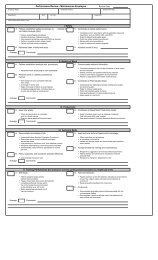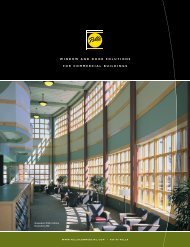Building Operating Management September 2011 - FacilitiesNet
Building Operating Management September 2011 - FacilitiesNet
Building Operating Management September 2011 - FacilitiesNet
You also want an ePaper? Increase the reach of your titles
YUMPU automatically turns print PDFs into web optimized ePapers that Google loves.
64<br />
energy consumed by the data center<br />
to the energy consumption of just the<br />
IT equipment (e.g., servers, switches<br />
and storage). <strong>Building</strong> owners with<br />
data centers in their buildings (usually<br />
in commercial office space) must<br />
work with tenants to ensure that they<br />
have the proper metering in place to<br />
capture the IT energy consumption<br />
output of the uninterruptible power<br />
supply (UPS).<br />
In March <strong>2011</strong>, EPA released an energy<br />
performance scale for senior care<br />
facilities. Now, nursing homes, assisted<br />
living communities, and certain<br />
types of continuing care retirement<br />
communities are eligible to earn the<br />
Energy Star. A senior care community<br />
is defined as all buildings in a multibuilding<br />
campus setting or a standalone<br />
facility that are designed to<br />
house and provide care and assistance<br />
for elderly residents including assisted<br />
living, skilled nursing, and select conbuildingoperatingmanagement<br />
SEPTEMBER <strong>2011</strong><br />
Just Connect...<br />
data center energy consumption is<br />
critical for our country’s energy security<br />
because of the energy-intensive<br />
nature of these operations. In 2006,<br />
data center and server energy use was<br />
estimated at approximately 61 billion<br />
kilowatt hours (kWh), or 1.5 percent of<br />
total U.S. energy consumption, costing<br />
approximately $4.5 billion. According<br />
to an EPA report to Congress<br />
published in 2007, the energy use of<br />
data centers, servers, and infrastructure<br />
more than doubled from 2000 to<br />
2006, and it is expected to continue to<br />
grow exponentially.<br />
In late 2010, EPA released an energy<br />
performance scale for data centers<br />
to enable operators to measure<br />
and compare their energy performance<br />
to similar facilities across the<br />
nation. During EPA’s analysis of data<br />
center energy use, which drew upon<br />
information from both stand-alone<br />
data centers and data centers located<br />
within commercial buildings, an important<br />
finding was that the variability<br />
in energy use was more dependent on<br />
energy management practices than<br />
on operating characteristics.<br />
EPA’s energy performance scale for<br />
data centers is based on a common industry<br />
metric, power usage effectiveness<br />
(PUE), which is the ratio of total<br />
There are now 14<br />
facility types which<br />
are eligible for a<br />
1 to 100 Energy<br />
Star score using<br />
Portfolio Manager,<br />
including data<br />
centers and senior<br />
care facilities<br />
Switch to extraordinary lighting control<br />
with Digital Lighting <strong>Management</strong><br />
Adding Digital Lighting <strong>Management</strong> switches offers:<br />
20-30% more energy savings with Manual-on<br />
80% higher ROI than Automatic-on<br />
20% Lighting Power Density credit in California Title 24<br />
Industry-exclusive self-commissioning DLM is like having<br />
a personal energy manager in every room. It gives you<br />
the flexibility to turbocharge your energy savings without<br />
breaking the bank.<br />
For more details on DLM visit<br />
www.wattstopper.com/DLM<br />
*Download savings<br />
information on<br />
your smartphone<br />
▲ FREE INFO: Circle 443 Booth #518





